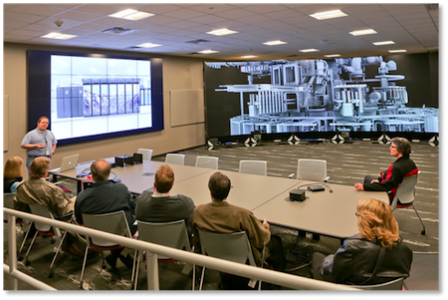New visualization capabilities assist researchers in breakthroughs

Upgrades to Oak Ridge National Laboratory’s (ORNL) EVEREST create a more immersive user experience for presentations to the public and visualizations done by scientists.
In January, ORNL’s Exploratory Visualization Environment for Research in Science and Technology (EVEREST) received an upgrade. For nearly ten years, researchers have seen their large datasets as images on the screens in the EVEREST room. With the new upgrade, scientists will be better able to visualize their data to make discoveries.
The renovations include a 37 mega pixel stereoscopic wall made up of 18 individual display monitors. Stereoscopy creates depth in an image for a 3D effect. While the old system could show movies, high-resolution images, and some live applications, the new system’s 3D capabilities will allow for greater detail in data visualization.
“The major goal of the upgrade is to make it easier to use as a scientific tool and to provide additional functionality including stereoscopic visualization of scientific data,” says National Center for Computational Sciences Visualization Task Leader Dave Pugmire.
The EVEREST room also includes a secondary display which is made up of 16 individual panels. Both the main wall and this smaller wall can be operated independently, which allows researchers to view more than one set of information simultaneously. Scientists working with big and versatile sets of data can see and compare images and datasets more easily with this added functionality.
Not only are the images shown in the new EVEREST facility more detailed than those seen in the old, but the upgraded EVEREST system is also easier to access because it can be driven by a laptop or a single desktop. The images on the screen can still be controlled by a cluster, but the added laptop capability makes the system easier to use for scientists and representatives from the Oak Ridge Leadership Computing Facility (OLCF) who are making presentations to the public. And because EVEREST uses the center-wide file system, users will be able to access their data from other OLCF computational resources, making it easy for researchers to view information from sources like Titan.—by Leah Moore




